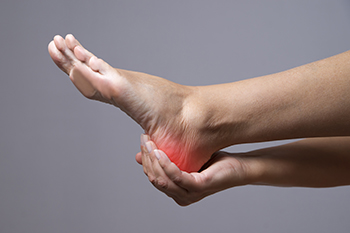
Falls at home often occur because of poor balance, reduced foot strength, or problems with sensation in the feet. When the muscles, joints, or nerves in the feet and ankles are weak or painful, balance can become unstable, increasing the chance of tripping. Wearing shoes that lack adequate support, such as flip-flops or worn-out slippers, can also make the feet more vulnerable to slipping. Proper footwear with firm soles and a secure fit helps improve stability and reduce strain on the arches and ankles. People with neuropathy, bunions, or arthritis can have difficulty sensing uneven ground or adjusting quickly to changes in surface texture. A podiatrist can assess foot strength, check for nerve or circulation problems, prescribe custom orthotics to improve balance, and recommend footwear that supports safer walking. If you are at risk for falling, it is suggested that you make an appointment with a podiatrist for a diagnosis and treatment.
Preventing falls among the elderly is very important. If you are older and have fallen or fear that you are prone to falling, consult with Paula F. Angelini, DPM from Board Certified Foot Care. Our doctor will assess your condition and provide you with quality advice and care.
Every 11 seconds, an elderly American is being treated in an emergency room for a fall related injury. Falls are the leading cause of head and hip injuries for those 65 and older. Due to decreases in strength, balance, senses, and lack of awareness, elderly persons are very susceptible to falling. Thankfully, there are a number of things older persons can do to prevent falls.
How to Prevent Falls
Some effective methods that older persons can do to prevent falls include:
- Enrolling in strength and balance exercise program to increase balance and strength
- Periodically having your sight and hearing checked
- Discuss any medications you have with a doctor to see if it increases the risk of falling
- Clearing the house of falling hazards and installing devices like grab bars and railings
- Utilizing a walker or cane
- Wearing shoes that provide good support and cushioning
- Talking to family members about falling and increasing awareness
Falling can be a traumatic and embarrassing experience for elderly persons; this can make them less willing to leave the house, and less willing to talk to someone about their fears of falling. Doing such things, however, will increase the likelihood of tripping or losing one’s balance. Knowing the causes of falling and how to prevent them is the best way to mitigate the risk of serious injury.
If you have any questions, please feel free to contact our offices located in Attleboro, Foxborough, Southborough, and Sudbury, MA . We offer the newest diagnostic and treatment technologies for all your foot care needs.

Proper shoe fitting is essential for keeping your feet comfortable and preventing unnecessary pain. The right shoes help you avoid foot strain and discomfort while supporting better balance and posture in daily activities. When shoes fit well, they also improve performance during physical activity by allowing the feet to move naturally and efficiently. Good footwear contributes to overall health and awareness by encouraging proper alignment and reducing stress on joints throughout the body. A podiatrist can assess your foot structure, recommend the best shoe type for your needs, and address any existing issues caused by wearing poorly fitting footwear. If you have foot pain from wearing shoes that do not fit correctly, it is suggested that you consult a podiatrist who can offer effective relief tips, and guide you on the correct shoes to wear.
Finding a properly-fitting shoe is important in reducing injuries and preventing foot problems. For more information about treatment, contact Paula F. Angelini, DPM from Board Certified Foot Care. Our doctor will treat your foot and ankle needs.
Proper Shoe Fitting
A common concern when it comes to foot health, having properly fitted shoes can help prevent injuries to the foot. Out feet affect our posture and gait, which in turn affects the biomechanics and overall bodily structure. With 33 joints, 26 bones, and over 100 ligaments, the potential for serious injury is much greater than one realizes. Although the feet cease growth in adulthood, they still change shape as they mature. Here are some factors to consider when it comes to investing in proper fitting shoes:
- Be sure the shoes fit correctly right away
- Ensure the ball of your foot fits comfortably in the widest portion of the shoes
- Even though they may look fashionable, improper fitting shoes can either create adverse conditions or exacerbate existing ones you may already have
- Walk along a carpeted surface to ensure the shoes comfortably fit during normal activity
Keeping in mind how shoes fit the biomechanics of your body, properly-fitting shoes are vitally important. Fortunately, it is not difficult to acquire footwear that fits correctly. Be sure to wear shoes that support the overall structure of your body. Do your feet a favor and invest in several pairs of well-fitted shoes today.
If you have any questions, please feel free to contact our offices located in Attleboro, Foxborough, Southborough, and Sudbury, MA . We offer the newest diagnostic and treatment technologies for all your foot care needs.

Heel pain in the morning can make those first steps of the day uncomfortable and difficult. Common causes include plantar fasciitis, which creates sharp pain from inflammation of the tissue along the bottom of the foot, and Achilles tendinitis, which causes stiffness and soreness at the back of the heel. Rheumatoid arthritis can lead to joint swelling and tenderness, while hypothyroidism may cause muscle and joint discomfort that contributes to heel pain. A podiatrist can evaluate the underlying cause through examination and imaging tests, then develop a personalized treatment plan to relieve pain and restore mobility. If morning heel pain is affecting your daily routine, it is suggested that you visit a podiatrist who can determine what the cause is, and offer effective relief and treatment solutions.
Many people suffer from bouts of heel pain. For more information, contact Paula F. Angelini, DPM of Board Certified Foot Care. Our doctor can provide the care you need to keep you pain-free and on your feet.
Causes of Heel Pain
Heel pain is often associated with plantar fasciitis. The plantar fascia is a band of tissues that extends along the bottom of the foot. A rip or tear in this ligament can cause inflammation of the tissue.
Achilles tendonitis is another cause of heel pain. Inflammation of the Achilles tendon will cause pain from fractures and muscle tearing. Lack of flexibility is also another symptom.
Heel spurs are another cause of pain. When the tissues of the plantar fascia undergo a great deal of stress, it can lead to ligament separation from the heel bone, causing heel spurs.
Why Might Heel Pain Occur?
- Wearing ill-fitting shoes
- Wearing non-supportive shoes
- Weight change
- Excessive running
Treatments
Heel pain should be treated as soon as possible for immediate results. Keeping your feet in a stress-free environment will help. If you suffer from Achilles tendonitis or plantar fasciitis, applying ice will reduce the swelling. Stretching before an exercise like running will help the muscles. Using all these tips will help make heel pain a condition of the past.
If you have any questions, please feel free to contact our offices located in Attleboro, Foxborough, Southborough, and Sudbury, MA . We offer the newest diagnostic and treatment technologies for all your foot care needs.
